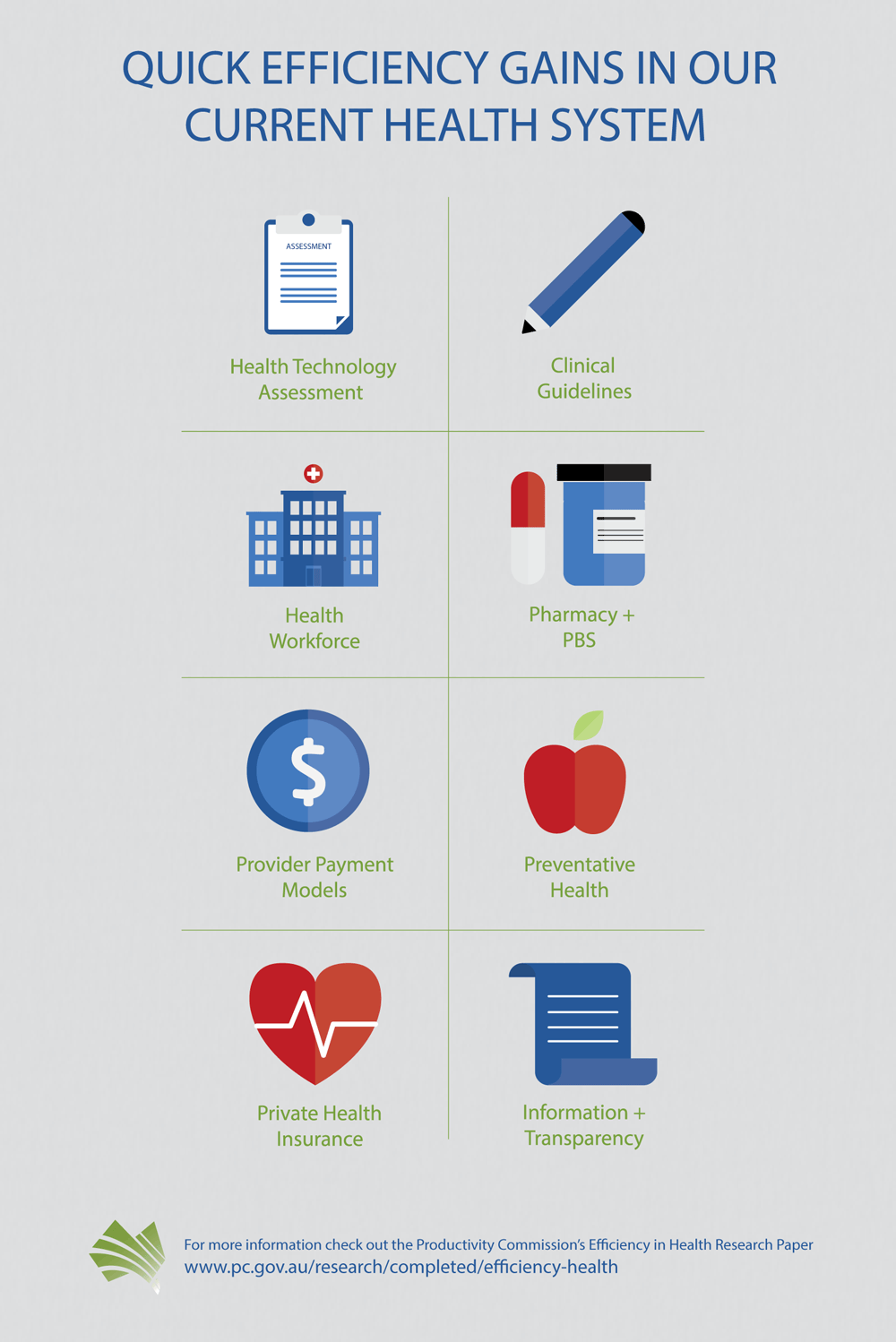Efficiency in health
Commission research paper
This paper was released on 23 April 2015 and in it the Commission has identified and assessed opportunities to improve the operation of Australia's health care system. This is based on a roundtable the Commission held with health policy experts in November 2014, as well as follow-up research.
Download the paper
- At a glance
- Media release
- Contents
Download this infographic

Quick efficiency gains in our current health system
- Health technology assessment
- Clinical guidelines
- Health workforce
- Pharmacy and Pharmaceutical Benefits Scheme (PBS)
- Provider Payment Models
- Preventative Health
- Private Health Insurance
- Information and transparency.
Read more detail in the paper.
Efficiency in Health
A Productivity Commission research paper — based on views offered at a roundtable held with health policy experts in November 2014 — has found that there are significant opportunities to improve the efficiency of Australia's health care system through reforms that can be delivered without changing existing institutional and funding structures, and without delay.
Benefits to patients are clear; and cost savings are equally self-evident.
In the paper, the Commission observes that shared and overlapping responsibilities for health care funding and service delivery often mean that many participants in the health system share responsibility, with the consequence that no one participant has the incentive to pursue reforms. Therefore, in outlining prospective areas for efficiency gains, and acknowledging the rough justice of it, the Commission has proposed a responsible party and provided a roadmap, including timelines.
| Participant | Organisation |
|---|---|
| Alan Castleman | Australian Centre for Health Research |
| Debora Picone | Australian Commission on Safety and Quality in Health Care |
| Alison Verhoeven | Australian Healthcare and Hospitals Association |
| David Kalisch | Australian Institute of Health and Welfare |
| Rohan Mead | Australian Unity |
| Jeffrey Richardson | Centre for Health Economics, Monash University |
| Clifford Hughes | Clinical Excellence Commission |
| Carol Gisz | Competition Policy Review Secretariat |
| Martin Bowles | Department of Health (Australian Government) |
| David Cullen | Department of Health (Australian Government) |
| Frances Diver | Department of Health (Victoria) |
| Pradeep Philip | Department of Health (Victoria) |
| Jim Birch | Ernst and Young |
| Stephen Duckett | Grattan Institute |
| Sharon Willcox | Health Policy Solutions |
| Tony Sherbon | Independent Hospital Pricing Authority |
| Shane Solomon | Independent Hospital Pricing Authority |
| Andrew Wilson | Medibank Private |
| Robyn Ward | Medical Services Advisory Committee |
| Anthony Scott | Melbourne Institute of Applied Economic and Social Research |
| Adam Elshaug | Menzies Centre for Health Policy, School of Public Health, University of Sydney |
| Barbara Yeoh | Monash Health |
| Ian Scott | Princess Alexandra Hospital |
| Ian Frazer | Translational Research Institute |
| Opportunities, reform actions and responsibilities | Timeframes | Outcomes |
|---|---|---|
| Health technology assessment | ||
|
Australian Government Minister for Health to:
|
|
|
| Evidence-based guidance for clinicians | ||
|
Australian Government Minister for Health to establish expert panels of clinicians to assess and endorse clinical guidelines, and to advise on dissemination, implementation and review |
|
|
| Provider payment models | ||
|
|
|
| Preventive health | ||
|
|
|
| Health workforce | ||
|
|
|
| Pharmacy | ||
|
|
|
| Pharmaceutical Benefits Scheme pricing | ||
|
Australian Government Minister for Health to:
|
|
|
| Private health insurance | ||
|
Australian Government Minister for Health to:
|
|
|
| Information and transparency | ||
|
|
|
- Preliminaries
- Cover, Copyright and publication detail, Contents and Abbreviations.
- Executive summary
- Chapter 1 Australia's health system
- Chapter 2 Promoting clinically and cost effective medicine
- 2.1 Health technology assessment
- 2.2 Evidence-based guidance for clinicians and patients
- 2.3 Provider payment models
- 2.4 Preventive health
- Chapter 3 Opportunities for regulatory reform
- 3.1 Health workforce
- 3.2 Pharmacy
- 3.3 Pharmaceutical Benefits Scheme pricing
- 3.4 Private health insurance
- Chapter 4 Information and transparency
- 4.1 Why does information matter?
- 4.2 What information could be better collected or released?
- 4.3 Overcoming impediments to reform
- 4.4 The way forward
- Chapter 5 Summing up
- References